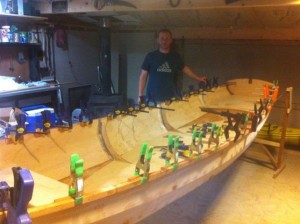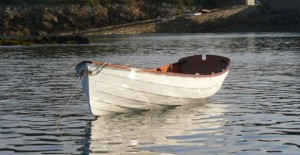In which the boys in the boatshed live on the edge before being run out of town on a rail.
ON FAIRNESS
I like to run my eye along a beautiful curve. When a line sweeps along a contour with a flowing motion it creates a sense of rightness that is part mathematics and fully sensual. Great boats are given shape through the discerning eye of a designer who can mold the symmetry of a hull to the fluid motion of the dynamic medium of water. Abrupt changes, wobbles and humps are an interruption in the form that follows the function of a seaworthy craft. A boat’s “sheer” is the line where hull meets deck, often delineated by the gunwale or rub rail. In boatbuilding we call that even undisturbed curve, “fair.” Getting it right is crucial and a point of pride for anyone who turns their hand to the craft of boatbuilding.
The Chester Yawl has a lovely sheer. It is in my opinion just right. The lowest point comes a bit farther than two thirds of the way aft of the stem. It rises gradually toward both ends in a dramatic but restrained curve higher at bow than at the stern. The weekend after completing the epoxying of seams, Dave Eckler gathered Caleb and myself to attach the rub rails to his boat and achieve the delineation that may forever mark his craft as a jewel.
CLAMPS A LOT
 This job was much less time consuming than our previous task. Success depended on two things: our eyes and a large quantity of clamps. Between the tool collections of the three of us we managed to gather about 50 clamps of various sizes and types. I have a special fondness for clamps of all kinds and sizes. No matter what your wife, children, physicist uncle, or preferred spiritual authority says, it is simply impossible to have too many of them. Most of mine come from garage sales because I’m cheap and I enjoy the thrill of the hunt. I brought a generous contribution to the project.
So far Dave has managed to have an adequate supply of tools and materials on hand. The Spanish Cedar lumber for the rails arrived as the only broken parts in the kit. Chesapeake Light Craft very quickly sent replacements. Each 15 foot rail comes in two parts with a pre-cut scarf joint. Dave had already glued the parts together on the previous day.
THE DRY FIT
As in most glue jobs our first task was to do a trial fitting. Each rail was screwed on to the hull at the bow through the planking into the breast hook. We then worked our way aft bending it into place and following the upper edge of the sheer plank. These planks are cut precisely on a CNC machine but we had also eyeballed the sheer to make sure they ran fair and mirrored each other from side to side. They did and we had little trouble positioning the rails. They were clamped on with just a few clamps at first. More were added as we worked to make sure the rail laid tight against the planking along it’s full length. The job goes best with two sets of hands. Of course once that was accomplished we congratulated ourselves and took the whole thing apart. Each clamp was laid on the floor adjacent to the position it would take up in the final glue-up.
BRINGING IT ALL TOGETHER
Rails such as these rely on adhesives in this day and age. Traditional construction would call for screws or rivets. The CLC manual frequently calls for epoxy thickened to mayonnaise consistency. It’s a sort of mantra with overtones of toxicity. Once again nitrile gloves were donned and the ritual of pumping and stirring began. Everybody grabbed a brush and began spreading epoxy goo on the backs of the rails. From there it was a simple matter of repeating what we had just done. There was a little extra fiddling with clamps as we settled the rails into place. At some places the curve flattened out a bit and additional clamps were applied for more localized pressure. With both sheer lines bristling with clamps we each took turns at sighting along the curve from the bow. To do this we had to open the front door so we could get our heads into position even with the prow.
Chesapeake Light Craft’s design calls for a single strip of Spanish Cedar on the outside of the plank. Dave was of the opinion that an inwale would provide a stronger and stiffer boat. A discussion arose over the necessity and means of accomplishing this. It was fueled by bottles of cold ale that had made their appearance about the time we were able to shuck the rubber gloves. Dave settled on a slotted gunwale consisting of an inner rail spaced away from the hull planking by 4 1/2 inch long blocks of cedar. This was done on a subsequent occasion which I was not present at. The result looks very nautical and should in fact provide a sheer strong enough to slam against the side of a barge in a moderately strong chop.
Contours and edges are the elements that strike the eye and become food for some part of the brain that defines beauty and balance, symmetry and substance. There are measures of form and beauty born of subjectivity which through common agreement become worthy standards of judgement. So it is that we have the Golden Ratio, the ellipse, Venus De Milo, and roller coasters.
With the rails in place we reached a point of satisfaction. The boat’s shape is almost complete although there are many small details to come in the following weeks. There is a skeg to add, some fiberglass on the bottom and a lot of raw wood is showing. At this point the mind easily constructs an image of the finished craft . We imagine her afloat riding the water like a feather come to rest on a stream which may carry her far and wide. The promise of this picture tells us that even without paint the effect will be quite pleasing.






Nice project and poetic thoughts. Thanks.
Have to echo your thoughts about the concept of a “fair” line. It’s what we strive for, and sets boatbuilding apart from the mostly rectilinear constructions that are in the built world around us. Though good carpenters and woodworkers with a high degree of skill will take on a curved project at times, few crafts immerse you in the curvilinear nature of wood the way boatbuilding does.
I wrote some about this in my blog…
Wood & Water, http://werkinprogrs.blogspot.com/2013/01/wood-and-water.html?m=0
Kayak build, http://werkinprogrs.blogspot.com/2011/02/blog-post.html?m=0
See you on the water soon!
It’s always nice to meet someone who “gets it” instinctively. Good job on the kayak. I have been threatening to commit a skin on frame project for a longtime as I like the Greenland style in both kayaks and paddles. We are very much ympatico in terms of curvilinear construction. Where I work I have been lucky enough to be involved in cabinet work that has curved lines. They are among my favorite projects and are probably the best work I have done for the company. Nature loves a curved line and so does the human eye. They are organic, sensual, cosmic and aesthetically liberating. As a sailor the best way to appreciate your boat is rowing away from her as she lies to a mooring. Looking back you may be entranced by the sweep of her sheer and lift of her stern proudly holding her name aloft for everyone to see it emblazoned on her transom.